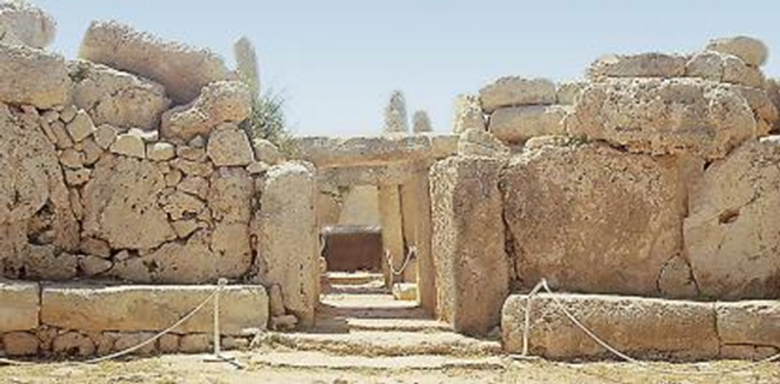Table of contents
PURPOSE OF THIS ARTICLE
As the title suggests, this article will summarize everything that has so far been discovered and said about this sacred site.
This article is not an explanation of the site. You’ll find it in a separate post, to follow, entitled:
LES TEMPLES DE MALTE : LA RÉSOLUTION DU MYSTÈRE
Before deciphering this site and its sacred raison d’être, I thought it would be useful, not to say necessary, to summarize everything that has been said and discovered about it by the world of archaeology. This will ensure that you know all the useful elements you need to memorize beforehand. All these elements will then be deciphered (in the article dedicated to deciphering this specific site), thanks to knowledge of the sacred prehistoric symbolic language, which, as you’ll see, will enable us to decipher the sacred meaning of each of these elements. As on all prehistoric sacred sites, this sacred symbolic language was abundantly used by the high priesthood to encode its teachings and doctrine, including its major doctrine: the rebirth of the father of the gods (deified primordial man) in the son-god through the mother-goddess (deified primordial woman) and her womb.
LINK THIS ARTICLE WITH THE ENTIRE LITERARY SERIES “THE TRUE HISTORY OF MANKIND’S RELIGIONS :
This article precedes the one devoted to explaining the mystery of the Stonehenge site, which you’ll find in a separate article on this site:
THE TEMPLES OF MALTA : THE MYSTERY SOLVED
or in the book entitled :
The megalithic temples of Malta, Göbekli Tepe and Stonehenge
which you can also find on sale in the following section:
Already published books
To find out why this book is part of the literary series The True Stories of Mankind’s Religions, go to page :
Introduction / Structure and Content
I hope you enjoy reading the full article below:
DATE FROM – 5,400 BC. J.-C. / MEGALITHIC TEMPLES OF MALTA AND HYPOGEUM OF HAL SALFIENI
SUMMARY OF INFORMATION AVAILABLE TO DATE
INTRODUCTION
The megalithic temples of Malta are a group of temples present in the Maltese archipelago, on the islands of Malta and Gozo. This small archipelago concentrates an important number of megalithic temples: currently seventeen inventoried sites regroup thirty-three temples. To these must be added fifteen or so other sites that represented at least as many additional temples, now lost under the bombs of the Second World War or the peak of the demolition workers.
Among the major sites, listed by UNESCO, are the seven megalithic temples Skorba, Ġgantija, Ta’ Ħaġrat, Ħaġar Qim, Mnajdra, and Tarxien.
They are monumental prehistoric constructions built during the IVth and IIIrd millennium before Christ.
USUAL PLAN
We can note in a synthetic way:
- Elliptical forecourt, concave facade, facade and walls in vertical slabs (orthostats) topped with horizontal blocks.
- Entrance in the center of the facade, leading through a monumental passage to a paved courtyard with semicircular chambers called apses, arranged symmetrically on either side of the main axis, sometimes with three apses or with additional courtyards with four, five and even, in one case, six apses.
- The monuments had corbelled roofs, probably covered with horizontal beams.
- The decorations are panels decorated with drilled holes and panels with bas-reliefs representing spiral patterns, trees, plants and various animals.
LOCATION OF THE MAIN SITES
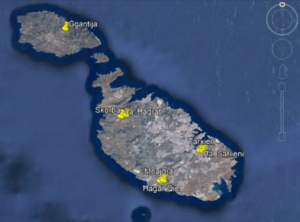
Google image/Gozo is the island to the northeast/Malta is to the southeast.
DATATION
Maltese megalithism, independent of Mediterranean or Western European megalithism, precedes by 400 to 700 years the oldest continental megalithic site, the cairn of Barnenez, which dates from 4,850 – 4,450 B.C., while the alignments of Carnac date only from 4,000 B.C.
To situate in time the Maltese megalithism, here is the commonly agreed time scale :
5,200 – 4,100 B.C. Neolithic period
- 5,200 – 4,500 BC Għar Dalam phase
- 4500 – 4400 BC Grey Skorba phase
- 4,400 – 4,100 B.C. Red Skorba phase
4,100 – 2,500 B.C. Temple period A
- 4,100 – 3,800 B.C. phase Żebbuġ
- 3,800 – 3,600 B.C. phase L-Imġarr
- 3,600 – 3,000 B.C. Ġgantija phase
- 3,000 – 2,900 B.C. Ħal Saflieni phase
- 2,900 – 2,500 B.C. Ħal Tarxian phase
2500 – 700 BC Bronze Age
- 2,500 – 1,500 B.C. phase of the Tarxian cemeteries
- 1500 – 725 BC Borġ in-Nadur phase
- 900 – 700 BC Baħrija phase
It is thus observed that the mastabas (2700 B.C.) and the pyramids of Egypt (2500 B.C.) are in fact contemporary with the last Maltese temples as well as Stonehenge (with its double horseshoe of blue stones [2600 B.C.], its triliths [2400 B.C.] and its circle of sarsen [reshaped until 1600 B.C.])
The great Maltese megalithic period ended about 700 years ago with the construction of the old temple of Knossos (1900 – 1800 BC).
Each monument is distinguished by its plan, its articulation and its construction techniques.
It is usually approached through an elliptical forecourt, located in front of a concave façade. The façade and the interior walls are made of vertical stone slabs, called orthostats, topped with horizontal blocks.
Generally, the entrance to the building is in the center of the façade, leading through a monumental passage to a paved courtyard. The interior of the buildings is made up of semicircular chambers, commonly called apses, arranged symmetrically on either side of the main axis. The number of apses varies from one monument to another, some have three apses opening onto the central courtyard, others have courtyards that follow one another with four, five and even, in one case, six apses.
The surviving rows of horizontal masonry elements indicate that the monuments had corbelled roofs, probably covered with horizontal beams. This method of construction was a remarkably elaborate solution for its time.
The decorated elements found in the monuments show a high level of craftsmanship. These elements consist mainly of panels decorated with drilled holes and panels with bas-reliefs depicting spiral motifs, trees, plants and various animals. The shape and plan of these constructions, as well as the art objects found inside, suggest that they were an important center for the practice of the rites of a highly organized society.
TEMPLE OF SKORBA (5 400 – 2 500 BC)
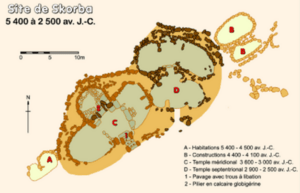
Map of the site of Skorba (at 118 m altitude)
/directed by Hamelin de Guettelet
Skorba, also spelled Sqolba, is the name of a group of megalithic temples, located in Żebbieħ, northwest of the island of Malta.
There are two temples, an early southern temple from the Ġgantija phase (3,600 – 3,000 BC), and a northern temple from the Tarxian phase (2,900 – 2,500 BC). The oldest remains consist of an 11 m long wall dating to the first half of the 4th millennium BC.
The southern temple has a trefoil shape with three apses. It is oriented along a southeast/northwest axis. It measures approximately 20 x 12 m, in an enclosure of 25 x 15 m.
An important detail is the stone paving at the entrance to the temple. These slabs, six in number, have five holes in three of them. These holes are interpreted by D. H. Trump as being intended to receive libations.
A 3.90 m high block, used for the construction of the inner embrasure, seems to be related to a later redevelopment of the Tarxian phase. This block has the particularity of being made of globigerine limestone, absent from the geological environment near the temple. The nearest quarry is more than 1,500 m away, and the transport of a block of several tons in a rugged landscape is in itself a kind of feat.
The northern temple, although more recent, is poorly preserved. Approximately 15 x 15 m, it is adjoined to the first one along a south-north axis.
The excavation of the site brought to light stone and terracotta figurines. These are stylized female torsos, but clearly showing breasts and pubic triangle. Also found, bovine bones worn by friction to give them the shape of phalluses, and goat skulls smashed as one might see in a slaughterhouse.
TEMPLE OF ĠGANTIJA (4,100 TO 3000 BC)
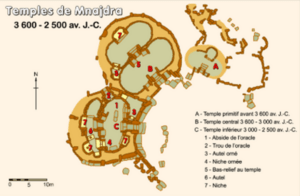
Plan of the temple of Ġgantija/Plan made by Hamelin de Guettelet
Ġgantija (“tower of the giants” in Maltese) is the name of a complex of two megalithic temples in Malta located in the center of the island of Gozo near the town of Xagħra, with a southern and a northern temple.
The southern temple (28 × 24 m) is of trefoil form (perhaps 4,100 B.C. in a primitive form) preceded by a double-apse hall (3,600 B.C.).
The northern temple (20 x 18 m) is a succession of two double-apse rooms (post-3,600 B.C.). The back room has a niche instead of the traditional frontal apse. The site was used between 4,100 and 3,000 BC.
In the southern temple, the apse on the right as you enter seems to have a particular importance for the cult. A stone screen, preceded by a fireplace, delimits the back of the apse. There are two low altars sculpted with spirals, arranged on steps forming a platform. Above is a niche that was to receive the perfectly polished conical stone (1 m high), which is now on display in the National Museum of Archaeology. The apse on the left revealed during the excavations a clay plaster coating decorated with red ochre. The corridor leading to the apses at the back is made of upright stones decorated with small concavities. The left apse has three niches made of perfectly squared blocks still showing traces of tools, perhaps metallic.
TEMPLE OF Ta’ Ħaġrat (3,600 to 3,000 B.C.)
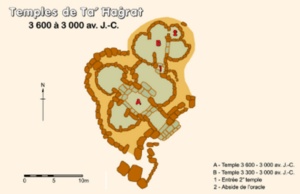
Plan of the temple of Ta’ Ħaġrat/done by Hamelin de Guettelet
The megalithic temple complex of Ta’ Ħaġrat is dated to the Neolithic period. It is located in L-Imġarr, on the island of Malta, very close to Skorba. It is the reference site of the Mġarr phase (3800 – 3600 BC) 1.
The first three-lobed temple, oriented southeast/northwest, is 18 x 16 m. It is dated to 3,600 – 3,000 BC. The second temple, with four apses, oriented south-north, is smaller. It is 10 x 8 m, and is dated 3,300 – 3,000 BC. Its entrance is not external, it is in the eastern apse of the first one.
They are both built of large dry stones. The first temple has a megalithic entrance flaring inward onto the central space. Excavations have revealed that these two temples were built on an older site dating from 4100 – 3800 BC.
Discovered during the excavations, a miniature (6 x 4 x 5 cm) in limestone represents an oval-shaped temple. It is possible to recognize the trilithic portal, the walls made of large stones, and a roof made of large slabs. It is therefore necessary to imagine these temples, today in the open air, as having included a lithic cover.
TEMPLE OF MNAJDRA (3 600 TO 2 500 BC)

Plan of the temple of Mnajdra/Plan realized by Hamelin de Guettelet
Mnajdra is located near the town of Qrendi, 500 m from Ħaġar Qim, near the southern shore of the island of Malta. The site rises 200 m from the Mediterranean Sea, above the cliffs, the islet of Filfla visible 5 km offshore.
” … ” The temples are mainly composed of corbels and smaller stones, and columns and lintels using large limestone slabs.
” … ” The cloverleaf plan of Mnajdra is more regular than that of Ħaġar Qim and seems reminiscent of the earlier temple at Ġgantija. The prehistoric structure consists of three joined, but not connected temples: the upper, middle, and lower temples:
- The upper temple is the oldest structure in the Mnajdra complex and dates to the Ġgantija period (3600-3200 BC). It is a building with three apses, the entrance to which is formed by a hole cut in a large vertical limestone slab, a type of construction typical of other megalithic entrances in Malta. The temple appears to have originally had a vaulted ceiling, but only the base of the ceiling is still in place at the top of the walls. The pillars are decorated with holes drilled in horizontal rows on their inner surface.
- The middle temple was built at the end of the Tarxian period (3150-2500 BC) and is the most recent structure. It is made of slabs topped with horizontal stones.
- The lower temple, built in the early Tarxian period, is the best preserved and most impressive structure. It has a forecourt containing stone benches, an entrance passage covered with horizontal slabs and the remains of a possible domed roof. The temple is decorated with spiral carvings and indentations, and pierced with windows, some overlooking smaller rooms and one overlooking a set of stones.
- The lower temple is astronomically aligned and may have served as an astronomical observation site or calendar. At equinoxes, sunlight passes through the main entrance and illuminates the axis of the temple. At solstices, it illuminates the edges of the megaliths to the right and left of this entrance.
” … ” In December 1949, two small statues, two large bowls, tools and a large round stone, probably used to move the stones of the temple, were discovered.
TEMPLE OF Ħaġar Qim (3,600 A 2,500 BC)
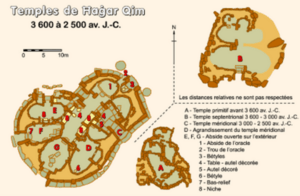
Plan of the temple of Hagar Qim / made by Hamelin de Guettelet
The Neolithic site of Ħaġar Qim is located near the town of Qrendi, above the cliffs in southern Malta.
The ruins of four temples are spread over a period of a thousand years (3,600-2,500 BC). The remains of the oldest building are now difficult to identify. To the south of the site, ruins, now difficult to read (about 18 × 12 m), date back at least to the Mġarr phase (3,800-3,600 BC). To the north of the site, the northern temple (25 × 20 m) shows a polylobed plan of the Ġgantija phase (3,600-3,000 bc).
At the center of the site, the southern enclosure wall (ca. 35 × 28 m) encompasses a temple and a succession of additions/remodels over a period of at least five centuries. The original temple (3,000-2,500 B.C.) with four apses and a distal apse replaced by a niche was first enlarged by a room communicating with the second western apse. The three later expansions have in common an originality with respect to the canonical plan, they open directly to the outside and have no internal communication between them. The Ħaġar Qim complex, built entirely of stone cut from globigerine limestone, marks the culmination of the architectural aestheticism of the “temple culture” that spans 3,000-2,500 BC 4,5.
On the northeast façade, just beside the corridor giving access to the oracle hole, there is a sanctuary with two betyls; a slender one, supposedly representing the male sex, and a much lower one, trapezoidal in shape, supposedly representing the female sex. To the left of the betyls, the largest enclosure stone used in a Maltese temple is 6.4 m long by 5.2 m high and weighs an estimated twenty tons. The excavations brought to light in the first western apse the “Venus of Malta”, a very naturalistic female nude statuette, found without a head.
TEMPLE OF TARXIAN (3 600 TO 2 500 BC)
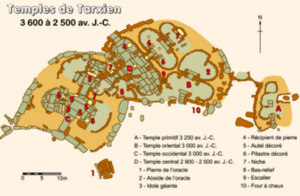
Plan of the temple of Tarxien / made by Hamelin de Guettelet
The Temples of Tarxien form a complex of four religious buildings
The primitive temple, to the east, is dated to 3250 BC during the Ġgantija phase (3600-3000 BC). Oriented south-north, about 15 x 10 m, the remains are difficult to decipher although restoration suggests a small temple with five apses.
The eastern and western temples are dated to 3,000 B.C. during the Saflieni phase (3,000-2,900 B.C.), and both are oriented southwest/northeast. The eastern temple, the simplest, but perhaps the best worked, is about 20 x 20 m. The two apses at the back, of which there are two, are the most important. The two apses at the back, including the one on the right called the oracle apse, are made of large perfectly fitted slabs, slightly inclined inwards and embedded in the bedrock.
The western temple with five apses is about 25 x 25 m. It has a traditional concave façade with a perfectly cut and framed stone at each end (today only at the southern end), pierced with several holes. The archaeologists, following T. Zammit, think of the divinatory stone of a small sanctuary. Once past the monumental entrance, rebuilt in 1956, the first apse on the right shelters the lower part of a colossal statue that must have been nearly 3 m high. The size of this statue can only make one think of an idol and not a human representation. Its resemblance to other statuettes discovered at several sites confirms the idol status of all these statuettes. What is most remarkable in this temple is the number of stones sculpted in low relief with geometric motifs (volutes, spirals…) or animal motifs (goat, pig…). One of these decorated stones has a half-moon-shaped opening, blocked by a perfectly fitted and decorated stone. Excavations have revealed that this stone gave access to a space where offerings and the ritual stone knife were deposited.
The central temple comes between the two preceding temples, it is dated to the Tarxian phase (2,900-2,500 BC). It is a temple with six apses and a distal niche oriented also south-west/north-east of about 28 x 20 m. It communicates with the outside only through an entrance in the first northern apse, but its main entrance is accessible through the second southern apse of the western temple.
EVOLUTION OF THE TEMPLES
An interesting diagram of the evolution of the temples can be found on the YouTube Arcana site:
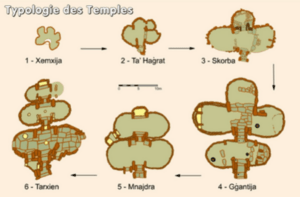
Arcana The mysteries of the world
TOMB OF XEMXIJA
Notice that the Site of Arcana mentions as a scheme the tomb of Xemxija. Indeed, it would be the model from which the temples were then designed.
Here is the description of this site of Xemxija made by Jess Emma Thompson:
The Xemxija Tombs include seven rock-cut tombs in the upper coral limestone of the Xemxija Plateau, on the crest of a hill overlooking St. Paul’s Bay.
Each grave is accessible through a small entrance shaft in the plateau which may have originally been blocked by large stones. The entrance shafts lead to
to domed chambers, some with steps preserved in the rock (see Appendix 2.1 for plan and sectional drawings of each tomb). The tombs may have originally been presented as cavities in the limestone that were later enlarged. Graves 1 and 2 have three internal lobes, supported by limestone columns; these graves are now interconnected, but were originally constructed separately. Tombs 3 and 4 are simpler, both with a single kidney-shaped chamber.
Tomb 5 is the most complex, with five lobed chambers radiating from the entrance. ” … “
All except Tomb 4 contained ceramics (Appendix 2.2), including patterned tile bowls characteristic of the Ġgantija phase (Evans 1971, 112-116). Some tombs may have been constructed during the Ġgantija phase, while Tomb 5 may date to the later Saflieni
phase (Evans 1971, 115; Pace 2004, 165).
Curiously, this tomb contained the largest assemblage of artifacts, including 12 ceramic bowls and basins, as well as personal ornaments (five Spondylus shells with V-shaped perforated buttons, two Spondylus shell beads, three shell pendants, and two miniature greenstone axe pendants)
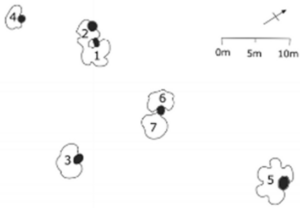
Plan of the Xemxija tombs (redrawn after Trump 2002, 163).
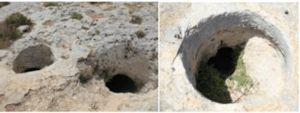
Entrances to tombs 1 and 2 (left) and tomb 5 (right), photos by the author/Tombs of Xemxija
(Jess Emma Thompson’s thesis October 2019/Magdalene College, University of Cambridge)
HYPOGEUM OF HAL SAFLIENI IN MALTA
SUMMARY OF THE INFORMATION AVAILABLE TO DATE FROM THE SITE
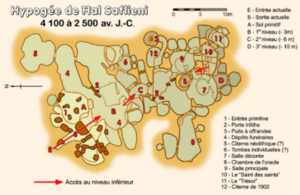
Plan of the hypogeum of Ħal Saflieni / made by Hamelin de Guettelet
Description
The site contains about fifty rooms on about 2,500 m2 spread over four levels. The primitive floor level, with the restoration of the entrance to the hypogeum, the first level, at about – 3 m, includes the first chambers dated to the Żebbuġ phase (4,100-3,800 BC) and the expansions of the Ġgantija phase (3,600-3,000 BC). The second level, at about -6 m, with the finest rooms, and then the third level, at just over -10 m, date to the Tarxian phase (3,000-2,500 bc) 7.
Primitive soil:
The restoration of the site at the end of the twentieth century allowed the development of the initial level. The entrance to the site is now through this level and no longer directly on the second level. Moreover, it is now possible to see the trilithic portals marking the entrance to the hypogeum as well as a first offering well, where a statuette of a steatopygic woman without a head as well as two heads without a body were discovered.
First level:
The first level includes, directly on the right, but also in the first room on the left, the places where the vast majority of the bones were discovered. Zammit has estimated the total number of skeletons that the hypogeum housed at about 7,000. Today, only six dolichocephalic skulls remain, stored in two boxes in the National Museum of Archaeology in Malta. At the end of the room on the left, a large, relatively deep space is interpreted by specialists as possibly being a cistern dating from 4000 BC. Still on the left, a trilith suggests a partition of this space.
Second level:
The second level is the largest; its plan is the most complex and the most remarkable. Immediately to the left is a room that seems to be unfinished (the surface of the walls does not have the same aspect of finish everywhere), but which is nevertheless decorated. Its ceiling has 14 discs of red ochre. The small alcoves of this room have led archaeologists to say that this place was reserved for more or less individual burials. Moving forward in the hypogeum, on the right is a room called “the oracle’s room” with a ceiling decorated with ochre spirals in the spirit of the bas-reliefs discovered in the temple of Tarxien. A small opening in the wall gives onto a niche, itself decorated, called “niche of the oracle” because of the echo that resounds in the temple if one speaks in the opening. Today, specialists think that it is the location of a statue or a cult object.
Still advancing towards the bottom of the hypogeum, one enters a new room with a ceiling decorated with scrolls inscribed in pentagons. It is here that the second offering well is located, where the archaeologists discovered amulets, jewels and the famous “Sleeping Lady”:
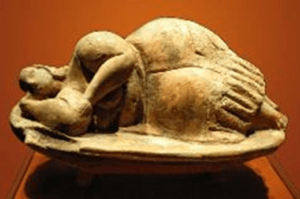
Sleeping Lady (National Museum of Archaeology in Valletta)
Behind the offering well are the three most remarkable rooms of the hypogeum: the main chamber (supposed to be a place of worship), the “Holy of Holies” (supposed to be reserved for the officiants) and the “Treasury”. (supposedly reserved for the officiants) and the “Treasury (supposed to be a place of burial). These rooms have the particularity, never found in any other hypogeum, that their walls represent, sculpted in globigerine limestone, all the external and internal appearances of surface temples, with their trilithic entrances, their orthostats, their altars, their corbelled vaults, their benches, etc. The treatment of the stone, particularly careful, gives the whole a real monumental aspect.
Third level:
A staircase, partly revolving, composed of seven steps, the last of which, on two upright stones, is quite high in relation to the ground, gives access to the third level. Here the rooms, located for the most part under those of the upper level, are arranged in such a way that they leave pilasters supporting the load of the upper level. Traces of red ochre suggest a rich decoration. The function of these rooms is subject to controversy, some wanting to see them as reserves protected by a dangerous staircase in the dark.
EVIDENCE OF THE CULT OF THE MOTHER GODDESS
To understand this site in harmony with what has already been demonstrated elsewhere, it is also necessary to note that the cult of the mother goddess is evident.
Indeed, were found on the spot figurines see elements of statue of goddess-mother, moreover, with particular characteristics.
Here is what the local mother goddess must have looked like, here in a standing position:
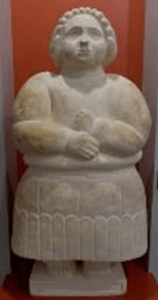
Replica of the figurine found in Ġgantija (available at the tourist center in Ġgantija.)
It is remarkable that the colossal idol (2.5 meters) that stands in the right apse after the main entrance of the western temple of Tarxien is this mother goddess.
Here is what remains of the base of the statue still present on site:

WK/Temples of Tarxian/Galichon-Jerome-Temples-of-Tarxian
Obviously, it looks like two drops of water to the dress with which the figurine of Ggantija is dressed.
It should be noted that, compared to the figurine of the mother-goddess represented standing, on this site, the fact that the legs are visible suggests that she is represented as sitting.
This is the opinion of Mr. Evans, quoted by Mr. Ferguson:
The figure must have been about two meters high when it was intact” . The figure was undoubtedly presented as sitting. Some of the statuettes found in Tarxien give a good idea of what it must have been like when it was complete. ” (Evans 1971; 120) (the temple builders of Prehistoric/Malta Doctoral thesis by Ian F.G.Ferguson for the University of London Ph. D in Archaeology/p.187)
Here are some molds from the local museum reproducing figurines of the local mother goddess found on site.
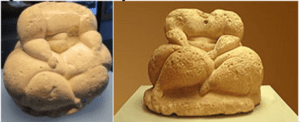
Mould reproduction of the steatopyge mother-goddess (i.e. with very large buttocks), found without head. Museum of Malta
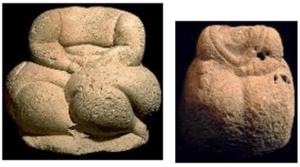
Statuettes found in Hagar Qim
http://web.infinito.it/utenti/m/malta_mega_temples/stattuet/statt/stat/sitknee.html

Sleeping Lady (National Museum of Archaeology in Valletta)
Visibly corresponding to the one discovered at the offering well of the hypogeum of Ħal Saflieni
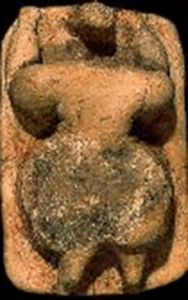
Another sleeping woman (?) from the hypogeum of Hal Saflieni.
Made of polished brown clay, the figure is turned down and appears to be naked from the waist down. The neck is missing and part of the back is broken, but a pleated skirt can be distinguished from what remains.
http://web.infinito.it/utenti/m/malta_mega_temples/stattuet/statt/stat/sitknee.html
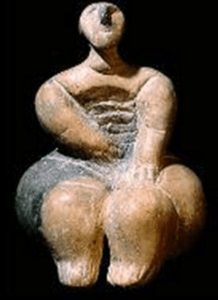
Figurine found during the excavation of the Circle of Xaghra (a burial site 400 m west of Ggantija).
Here is what Mr. Ferguson says in his thesis about these different figurines:
If the goddess figurines apparently symbolize motherhood (the supreme archetype of which is the mother nursing her baby), then they can reasonably be called mother goddess figurines. If they are found in an archaeological context such as a temple or shrine that is appropriate for cult practices, then it is reasonable to speak of a mother goddess cult (the temple builders of Prehistoric/Malta Doctoral thesis by Ian F.G.Ferguson for the University of London Ph. D in Archaeology/p.13).
So there is absolutely no doubt that we are on a site dedicated mainly to the mother goddess
Note, however, that certain characteristics of this local representation of the mother goddess are interesting when observing these figurines:
- She is plump. She has round and voluminous shoulders, arms, hips or buttocks, legs, thighs and calves.
- She is represented sitting or lying on her back, on her side or even on her stomach.
BIBLIOGRAPHY
THE MEGALITHIC TEMPLES OF MALTA
- https://whc.unesco.org/fr/list/132/
- https://fr.wikipedia.org/wiki/Skorba
- https://fr.wikipedia.org/wiki/Ggantija
- https://fr.wikipedia.org/wiki/Ta’Hagrat
- https://fr.wikipedia.org/wiki/Mnajdra
- https://fr.wikipedia.org/wiki/Hagar_Qim
- https://fr.wikipedia.org/wiki/Temples_de_Tarxien
- https://fr.wikipedia.org/wiki/Hypogée_de_Ħal_Saflieni
I would also like to take this opportunity to thank Hamelin de Guettelet for what I consider to be his exceptional work on the temple plans, without which this analysis would probably not have had the same resonance.
- Chaîne You Tube Arcana.
- https://www.youtube.com/watch?v=6EIZYWwSZAs
- Jess Emma Thompson’s thesis October 2019/Magdalene College, University of Cambridge
- The temple builders of Prehistoric/Malta Doctoral thesis by Ian F.G.Ferguson for the University of London Ph. D in Archaeology)
- http://web.infinito.it/utenti/m/malta_mega_temples/stattuet/statt/stat/sitknee.html
- Organisation latéralisée de l’espace et des activités dans un « temple » idéalisé (Malone et Stoddart 2009, 372)
- https://alka.hypotheses.org/1305
- https://fr.wikipedia.org/wiki/Trilithe
- Wikipedia/A. Pace – 2004 – p. 29 – 36/J. S. Tagliaferro [2000] p. 29.)
- https://fr.wikipedia.org/wiki/Maltais
- https://fr.wikipedia.org/wiki/Cybèle
REMINDER OF THE LINK BETWEEN THIS ARTICLE AND THE ENTIRE LITERARY SERIES “THE TRUE HISTORY OF MANKIND’S RELIGIONS”:
This article precedes the one devoted to explaining the mystery of the Stonehenge site, which you’ll find in a separate article on this site:
THE TEMPLES OF MALTA : THE MYSTERY SOLVED
or in the book entitled :
The megalithic temples of Malta, Göbekli Tepe and Stonehenge
which you can also find on sale in the following section:
Already published books
To find out why this book is part of the literary series The True Stories of Mankind’s Religions, go to page :
Introduction / Structure and Content
COPYRIGHT REMINDER
As a reminder, please respect copyright, as this book has been registered.
©YVAR BREGEANT, 2021 All rights reserved
The French Intellectual Property Code prohibits copies or reproductions for collective use.
Any representation or reproduction in whole or in part by any process whatsoever without the consent of the author or his successors is unlawful and constitutes an infringement punishable by articles L335-2 et seq. of the French Intellectual Property Code.
See the explanation at the top of the section on the author’s policy for making his books available:
Already published books
